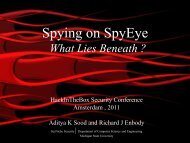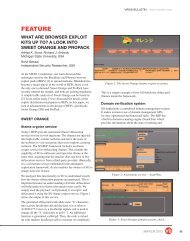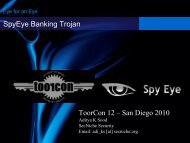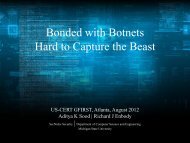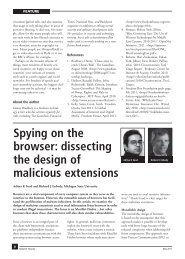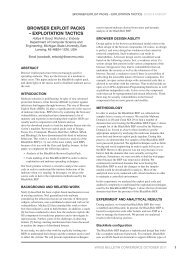Dissecting Java Server Faces for Penetration Testing - SecNiche ...
Dissecting Java Server Faces for Penetration Testing - SecNiche ...
Dissecting Java Server Faces for Penetration Testing - SecNiche ...
- No tags were found...
Create successful ePaper yourself
Turn your PDF publications into a flip-book with our unique Google optimized e-Paper software.
3 Inside JSF Framework<strong>Java</strong> <strong>Server</strong> <strong>Faces</strong> (JSF) is an industry standard and a framework <strong>for</strong> buildingcomponent-based user interfaces <strong>for</strong> web applications. JSF has certain standardsand is implemented using Reference Implementation (RI) by Sun Microsystems,Apache My<strong>Faces</strong> and Oracles ADF <strong>Faces</strong>. JSF primarily consists of <strong>Java</strong> Beans,Event Driven development and JSF component tree.With the advent of JSF, the control has been handed over to the developers<strong>for</strong> implementing security features such as authorization. As a result ofthis change, it has become more crucial <strong>for</strong> the developers to understand theimplementation of security controls in JSF framework. A good security designpractice requires that authorization (security controls) should be handled at acentral location (Servlet Filter associated with the application front controller).JSF has built-in extension points provided by the JSF architecture. As JSFhas no proprietary security architecture, the security has to be imposed in acustomized fashion. This is usually done in two ways• The developer can design a custom ViewHandler that adds security checks<strong>for</strong> createView and restoreView. However, it is not considered as the bestsecurity practice because there is no guarantee that the custom securityViewHandler is executed be<strong>for</strong>e the default ViewHandler. This leads tosecurity exceptions while handling requests from the web clients• The developer can design a phaseListener that adds security definitions torestoreView and invokeAction phases. This can be implemented in JSFfaces-config.xml file or the developer can do it dynamically by writing acustomPhase listener.3.1 JSF Security ArchitectureJSF is used <strong>for</strong> designing web based rich internet applications over the J2EEframework. <strong>Java</strong> applications are mostly designed using Model, View, and Controller(MVC) architecture due to the need <strong>for</strong> real time deployment. J2EEsecurity can be implemented through <strong>Java</strong> Authentication and AuthorizationService (JAAS) and container-managed security. JAAS implements fine-grainedaccess control through external <strong>Java</strong> permission classes, which provides user witha list of resources and allowed actions. Be<strong>for</strong>e J2EE, the security controls wereimplemented within the logic itself. J2EE framework has a declarative securitymechanism in which security controls are applied through web.xml deploymentdescriptors which in turn are handled by the J2EE container at runtime. Incontainer managed security, controls are applied using authorization which isexplicitly en<strong>for</strong>ced on the URL patterns (requests that are issued by the webclient).Generally, the controller is responsible <strong>for</strong> implementing security controlswhereas the view and model part are used <strong>for</strong> hiding in<strong>for</strong>mation and applyinglogic based on the access roles of the user respectively. However, a good design5




